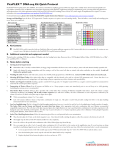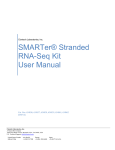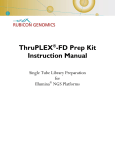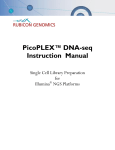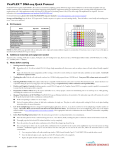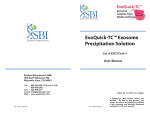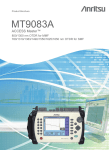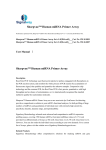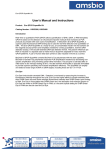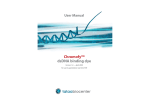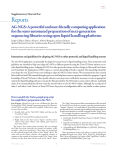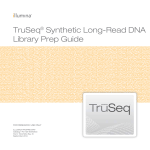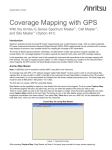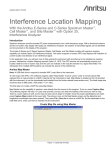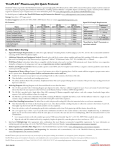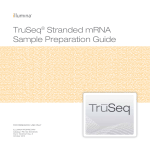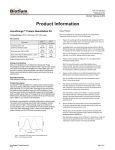Download ThruPLEX DNA-seq Dual Index Quick Protocol
Transcript
ThruPLEX® DNA-seq Kit Quick Protocol, Dual Indexes For Use With: ThruPLEX DNA-seq 48D Kit, CAT. NO. R400406 For Use With: ThruPLEX DNA-seq 96D Kit, CAT. NO. R400407 ThruPLEX® DNA-seq builds on the innovative ThruPLEX chemistry to generate DNA libraries with expanded multiplexing capability and with even greater performance. Kits contain either 48 or 96 dual read Illumina®-compatible indexes pre-dispensed and sealed in microplates. ThruPLEX DNA-seq can be used in DNA-seq, RNA-seq, or ChIP-seq and offers robust target enrichment performance with all of the leading platforms. For more information, please visit www.rubicongenomics.com/products/ThruPLEX-DNA-seq/. For detailed protocol, please refer to the ThruPLEX DNA-seq Kit Instruction Manual at www.rubicongenomics.com/resources/manuals/. Storage and Handling: Store kit at -20°C upon arrival. Prior to use, transfer enzymes to ice and centrifuge briefly. Thaw buffers, vortex briefly and centrifuge prior to use. Keep all enzymes and buffers on ice until used. Technical support: Call (734)-677-4845 (9AM-5:30PM EST) or contact [email protected]. Kit Contents Input DNA Sample Requirements Name Template Preparation Buffer Template Preparation Enzyme Library Synthesis Buffer Library Synthesis Enzyme Library Amplification Buffer Library Amplification Enzyme Nuclease-Free Water Indexing Reagents Quick Protocol Cap Color Red Red Yellow Yellow Green Green Clear 1 Dual Index Plate Nucleic acid Source Type Molecular weight Input amount Input volume Input buffer Requirement Fragmented double-stranded DNA or cDNA Cells, plasma, urine, other biofluids, FFPE tissues, fresh tissues, frozen tissues Mechanically sheared; enzymatically fragmented; ChIP DNA; low molecular weight cell-free DNA < 1000 bp 50 pg – 50 ng 10 µL ≤ 10 mM Tris, ≤ 0.1 mM EDTA A. Kit Contents ThruPLEX DNA-seq Dual Indexes i7 Index Sequence i5 Index Sequence D701 D702 D703 D704 D705 D706 D707 D708 D709 D710 D711 D712 ATTACTCG TCCGGAGA CGCTCATT GAGATTCC ATTCAGAA GAATTCGT CTGAAGCT TAATGCGC CGGCTATG TCCGCGAA TCTCGCGC AGCGATAG D501 D502 D503 D504 D505 D506 D507 D508 TATAGCCT ATAGAGGC CCTATCCT GGCTCTGA AGGCGAAG TAATCTTA CAGGACGT GTACTGAC See table above left. B. Notes before starting 1. Input DNA sample requirements: See table above middle. Please refer to the ThruPLEX DNA-seq Kit Instruction Manual for detailed instructions on preparing DNA samples. 2. Additional materials and equipment needed: Thermal cycler with 50 µL reaction volume capability and heated lid; centrifuge; PCR tubes or plates; PCR plate seals; low binding barrier tips; fluorescent dyes; Agencourt® AMPure® XP (Beckman Coulter, CAT. NO. A63880), 80% v/v Ethanol. 3. Selecting PCR Plates/Tubes: Select plates/tubes that are compatible with the thermal cyclers and/or real-time PCR instruments used. Ensure that there is no evaporation during the process by using proper seal/caps during cycling as evaporation may reduce reproducibility. 4. Positive and Negative Controls: If necessary, include a positive control DNA (eg. Coriell DNA, Covaris sheared, 200 – 300 bp,) and a No Template Control (NTC) as a negative control in parallel to ensure that the reaction proceeded as expected. 5. Preparation of Master Mixes: Keep all enzymes and buffers on ice. Library Synthesis Master Mix and Library Amplification Master Mix can be prepared during the last 15 minutes of the previous step’s cycling protocol and kept on ice until used. 6. Indexing Reagents: ThruPLEX DNA-seq is designed for high throughput applications. It is provided with a Dual Index Plate (DIP) containing either 48 or 96 Illuminacompatible dual indexes. Each well of the DIP has sufficient volume of Indexing Reagent for a single use and contains a unique combination of Illumina’s 8-nucleotide TruSeq® HT i5 and i7 index sequences (see table above right). 7. DIP Handling Instructions: The DIP is sealed with pierceable sealing foil and can be frozen and thawed no more than four times. Follow the instructions given below to avoid potential index cross contamination. Thaw the DIP for 10 min on the bench top prior to use. Once thawed, briefly centrifuge the plate to collect the contents to the bottom of each well. Thoroughly wipe the foil seal with 70% ethanol and allow it to dry completely. Pierce the seal above each well containing the specific index combination with a clean 200 µL filtered pipet tip; discard the tip. Use a new pipet tip to collect 5 µL of a specific index combination and add it to the reaction mixture at the Library Amplification Step. A multichannel pipette may be used if needed. If indexes from the entire plate are not used at the same time (low level multiplexing), follow the instructions below to avoid contamination: Cover any pierced index wells with scientific tape (such as VWR General Scientific Tape 0.5", CAT. NO. 89097-920) to mark the index as used. Once the Index Plate is used, wipe the seal with 70% ethanol and let it dry completely. Replace the plastic lid and return the plate to its sleeve and store at -20°C. 8. Low level multiplexing: Select appropriate dual index combinations that meet Illumina recommended compatibility requirements. For more information on multiplexing and index pooling, please see plate maps below and refer to the ThruPLEX DNA-seq Kit Instruction Manual at www.rubicongenomics.com/resources/manuals/. 9. Index Plate Maps: Dual Index Plate (48B or 48D) Dual Index Plate (96A or 96D) The index combination at each well position is indicated by the column (i7) and row (i5) labels on the plate maps. The well colors illustrate one way to pool dual-index combinations for an 8-plex experiment; wells sharing the same color should be pooled together. For other ways to pool a low-plex (2- to 16-plex) experiment, please refer to Illumina’s TruSeq Sample Preparation Pooling Guide (Illumina, Part# 15042173 Rev B, 2014). QAM-136-003 C. Quick Protocol I. Template Preparation Step 1. 2. Add 10 µL of DNA sample to each well of a PCR plate or tube. If necessary, include NTC negative control buffer sample(s) and positive control samples. Depending on the number of reactions, prepare the Template Preparation Master Mix as described in the table below. Mix thoroughly with a pipette. Keep on ice until used. Template Preparation Master Mix Component Cap Color Volume/Reaction Template Preparation Buffer Red 2 µL Template Preparation Enzyme Red 1 µL 3. 4. 5. 6. 7. To each 10 µL sample from step 1 above, add 3 µL of the Template Preparation Master Mix. Mix thoroughly with a pipette. Note: Final volume at this stage will be 13 µL. Seal the PCR plate using proper sealing film or tightly cap the tube(s). Centrifuge briefly to collect contents to the bottom of each well or tube. Place the plate or tube(s) in a thermal cycler with a heated lid set to 101C – 105C. Perform the Template Preparation Reaction using the conditions in the table below. Template Preparation Reaction Temperature Time 22°C 25 min 55°C 20 min 4°C Hold ≤ 2 hours 8. 9. 4. 5. Remove the seal on the plate or open the tube(s). Add 2 µL of the Library Synthesis Master Mix to each well or tube. Mix thoroughly with a pipette. Note: Final volume at this stage is 15 µL. Seal the PCR plate using proper sealing film or tightly cap the tube(s). Centrifuge briefly to collect contents to the bottom of each well or tube. Return the plate or tube(s) to the thermal cycler with a heated lid set to 101C – 105C. Perform Library Synthesis Reaction using the conditions in the table below. Library Synthesis Reaction Temperature Time 22°C 40 min 4°C Hold ≤30 min 8. 9. 7. 8. 1. 2. Remove the DIP from the freezer and thaw for 10 min on bench top. Prior to use, centrifuge the DIP to collect the contents at the bottom. Wipe foil seal with 70% ethanol and allow to dry. Prepare Library Amplification Master Mix as described in the table below. Mix thoroughly with a pipette. Keep on ice until used. Library Amplification Master Mix Component Cap Color Volume/Reaction Library Amplification Buffer Green 25.0 µL Library Amplification Enzyme Green 1.0 µL Nuclease Free Water Clear 4.0 µL (plus fluorescent dyes*) 3. 4. 5. 6. *Fluorescence dyes (for detection and optical calibration) are added when monitoring amplification in real time during cycling. Please refer to the Real Time PCR Instrument's user manual for calibration dye recommendations. The volume of detection and calibration dyes plus nuclease free water should not exceed 4 µL. If a regular thermal cycler is used, there is no need to add the dyes; use 4 µL of nuclease free water. Example: EvaGreen®/Fluorescein dye mix. Prepare by mixing 9:1 v/v ratio of EvaGreen Dye, 20X in water (Biotium, CAT. NO. 31000-T) and 1:500 diluted Fluorescein Calibration Dye (Bio-Rad Laboratories, CAT. NO. 170-8780); add 2.5 µL of this mix and 1.5 µL of nuclease free water per reaction. Remove the seal on the PCR plate or open the tube(s). Add 30 µL of Library Amplification Master Mix to each well or tube. Add 5 µL of the appropriate Indexing Reagent from the DIP to each well or tube. Note: Follow the DIP handling instructions (section B.7 of this quick protocol) to avoid index cross contamination. Mix thoroughly with a pipette. Avoid introducing excessive air bubbles. Note: Final volume at this stage is 50 µL. Seal the plate or tube(s) tightly and centrifuge briefly to collect contents to the bottom of each well or tube. Return plate or tube(s) to the real time PCR thermal cycler/thermal cycler with a heated lid set to 101C – 105C. Perform Library Amplification Reaction using the cycling conditions from the tables below. Caution: Ensure that the thermal cycler does not have a denaturing step programmed until Stage 3. Library Amplification Reaction Stage Temperature Time Number of Cycles 1 72°C 3 min 1 Extension & Cleavage 2 85°C 2 min 1 Denaturation 3 98°C 2 min 1 98°C 20 s Addition of 4 67°C 20 s 4 Indexes 72°C 40 s 5 to16 98°C 20 s Library 5 see table Amplification *72°C 50 s below 6 4°C Hold 1 *Acquire fluorescence data at this step, if monitoring in real-time. Remove the plate or tube(s) from the thermal cycler and centrifuge briefly. Continue to the Library Amplification Step. III. Library Amplification Step Prepare Library Synthesis Master Mix as described in the table below. Mix thoroughly with a pipette. Keep on ice until used. Library Synthesis Master Mix Component Cap Color Volume/Reaction Library Synthesis Buffer Yellow 1 µL Library Synthesis Enzyme Yellow 1 µL 2. 3. 7. Remove the plate or tube(s) from the thermal cycler and centrifuge briefly. Continue to the Library Synthesis Step. II. Library Synthesis Step 1. 6. Selecting the optimal number of amplification cycles: The number of PCR cycles required at Stage 5 of the Library Amplification Reaction is dependent upon the amount of input DNA and the thermal cycler used. We recommend performing an optimization experiment to identify the appropriate number of PCR cycles needed. The table below provides the suggested number of PCR cycles at Stage 5 for different input amounts. Stage 5 Amplification Guide DNA Input (ng) Number of Cycles 50 5 20 6 10 7 5 8 2 10 1 11 0.2 14 0.05 16 9. Note: Over amplification could result in a higher rate of PCR duplicates in the library. Remove the plate or tube(s) from the thermal cycler and centrifuge briefly. Note: At this stage, samples can be processed for next generation sequencing (NGS) immediately or stored frozen at -20°C and processed later. For instructions and recommendations on library pooling, purification, quantification, and sequencing, please refer to the ThruPLEX DNA-seq Kit Instruction Manual at www.rubicongenomics.com/resources/manuals/. For technical support contact [email protected] or call +1.734.677.4845 (9 AM – 5:30 PM EST). ThruPLEX® DNA-seq Kit is for research use only. It may not be used for any other purposes including, but not limited to, use in diagnostics, forensics, therapeutics, or in humans. ThruPLEX DNA-seq may not be transferred to third parties, resold, modified for resale or used to manufacture commercial products without prior written approval of Rubicon Genomics, Inc. ThruPLEX DNA-seq is protected by U.S. Patents 7,803,550; 8,071,312; 8,399,199; 8,728,737 and corresponding foreign patents. Additional patents are pending. Trademarks: ThruPLEX®; Illumina®, TruSeq® (Illumina Inc.); EvaGreen® (Biotium Inc.); Agencourt®, AMPure® (Beckman Coulter, Inc.). QAM-136-003


